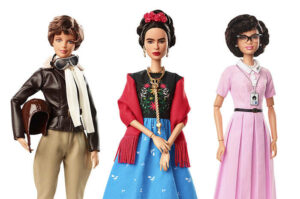
Different mediums have long been used to inform on the past. Music has shown the shifting political climate of different decades, movies have tracked changes in fashion and art has provided insight into the lives of various cultures. Objects, too, have found themselves to be interesting markers of time, showing shifts in technology and the comparative advancement of different countries through the lineage of mundane objects like typewriters, telephones, and even children’s toys.
Since her debut in 1959, Barbie has captured the hearts of little girls everywhere. The franchise has grown to include everything from dolls and accessories to movies, books and even stage productions. What started as a simple child’s toy quickly became a household name and powerful organization for change. Among other things, it has also become a unique indicator of women’s history throughout the years.
Barbie founder Ruth Handler was first inspired to create the doll while watching her children play pretend. She noticed her son’s action figures allowed him to be everything from a doctor to a firefighter, but her daughter’s dolls, in the form of babies and young children, only allowed her to be one thing: a mother. Wanting her daughter and other little girls to have the opportunity to dream other dreams for themselves aside from motherhood, Ruth created an older doll that opened up a world of possibilities of what life could be like for them in the future.
From the doll’s release up to present time, Barbie has evolved along and in response to the events, people, and circumstances in the world. Not long after Barbie’s debut, the Civil Rights movement gained traction and catalyzed another wave of feminism. Women entered the workforce in droves, spurred by purpose and passion in areas outside the home. At the same time, Barbie released its first set of career girls. These dolls took the form of a flight attendant, RN, fashion editor and general career girl. As women began to gain autonomy and wealth of their own, they became consumers of big-ticket items like cars and houses. In 1962, Barbie created a car and dream house, accessories that help show little girls the value and rewards of work and independence. Continuing the push for equal rights, Barbieintroduced Christie, Barbie’s friend and one of the first African America dolls on the market. Later on, in 1980, it also released other dolls of diverse colors, choosing to show inclusion in naming them Barbie instead of giving them a different name as they had done with Christie. This incorporation of different colored dolls under the same name gave little girls across the board a common ground and helped them to better picture themselves and the future they desired. Not long after Barbie’s introduction of diverse dolls, it also released its dolls of the world collection, teaching about the fashion and culture of people around the world.
In 1971, Barbie’s original demure face with averted eyes was replaced by a new one that depicted confidence and a forward-facing gaze. This change in Barbie’s appearance directly reflected the confidence women were gaining in themselves from establishing independence. As women moved from just being in the workforce to holding significant positions of power, Barbie celebrated with the release of CEO Barbie. As their presence also began to extend to the military and wartime efforts, Barbie generated its own soldiers in the form of dolls representative of the army, air force, and navy.
Even today as technology advances and new topics that affect girls and women arise, Barbie has found ways to respond to these areas and hot button issues. On its website, Barbie now runs an animated vlog, where the character of Barbie, posing as a girl in the world today, talks about various issues she has faced herself or witnessed, covering topics from bullying and resolutions to racism and the ‘sorry-reflex’, the inherent response of girls to apologize when they have nothing to be sorry for. Barbie has also expanded its reach to the adult population by providing resources for parents, including ways of introducing STEM to girls and why imagination, creativity and play are important parts of the early girlhood experience.
From its conception, Barbie has both tracked the progress of women’s history and shown little girls around the world what could be if they only dare to dream. Dolls have been released celebrating the beauty in different cultures as well as honoring women of the past and today who have made an impact. From the Civil Rights Movement and waves of feminism that sprang from it to the rise of women in the workforce and present day topics affecting girls, Barbie has played an impactful role in preserving the past and shaping the future.
-Emily VanderBent
Junior Girl
Girl Museum Inc.
